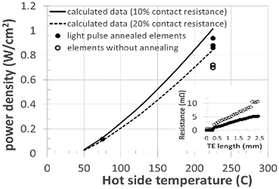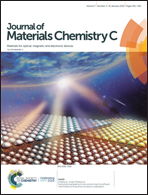Pulsed-light surface annealing for low contact resistance interfaces between metal electrodes and bismuth telluride thermoelectric materials
Abstract
Traditional deposition methods of electroplating, sputtering and evaporation can produce weak and inconsistent interfaces between the electrode contact and Bi2Te3-based nanostructured thermoelectric (TE) materials. The electrode contact layers with low bonding strength are mainly due to the severe damage to the top layer of the TE material during surface preparation. We report a novel and cost-effective method for the surface preparation of thermoelectric materials (Bi2Te3) using pulsed light annealing prior to nickel electroplating. Short duration high-energy light absorption at the surface of the TE material causes reflow and annealing of surface structures, which enhance the electrical and thermal flow across the interface through more consistent and stronger bonding between the electrode metal and TE material. An electrical contact resistance reduction on the order of 5 μΩ cm2 and a pull strength of around 8 MPa were reproducibly measured for both p-type (Bi0.5Sb1.5Te3) and n-type (Bi2Te2.7Se3) compositions compared to electroplated nickel samples that did not receive pulsed light annealing treatment. This novel technique for surface preparation prior to metallization is applicable to a range of TE materials, and will lead to a significant improvement in the performance of TE modules and devices.



 Please wait while we load your content...
Please wait while we load your content...